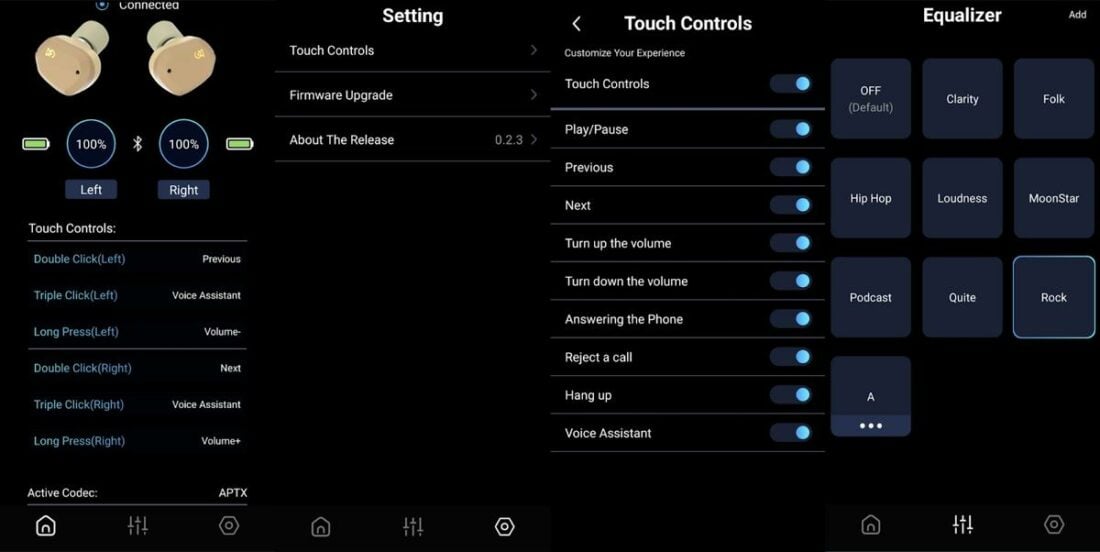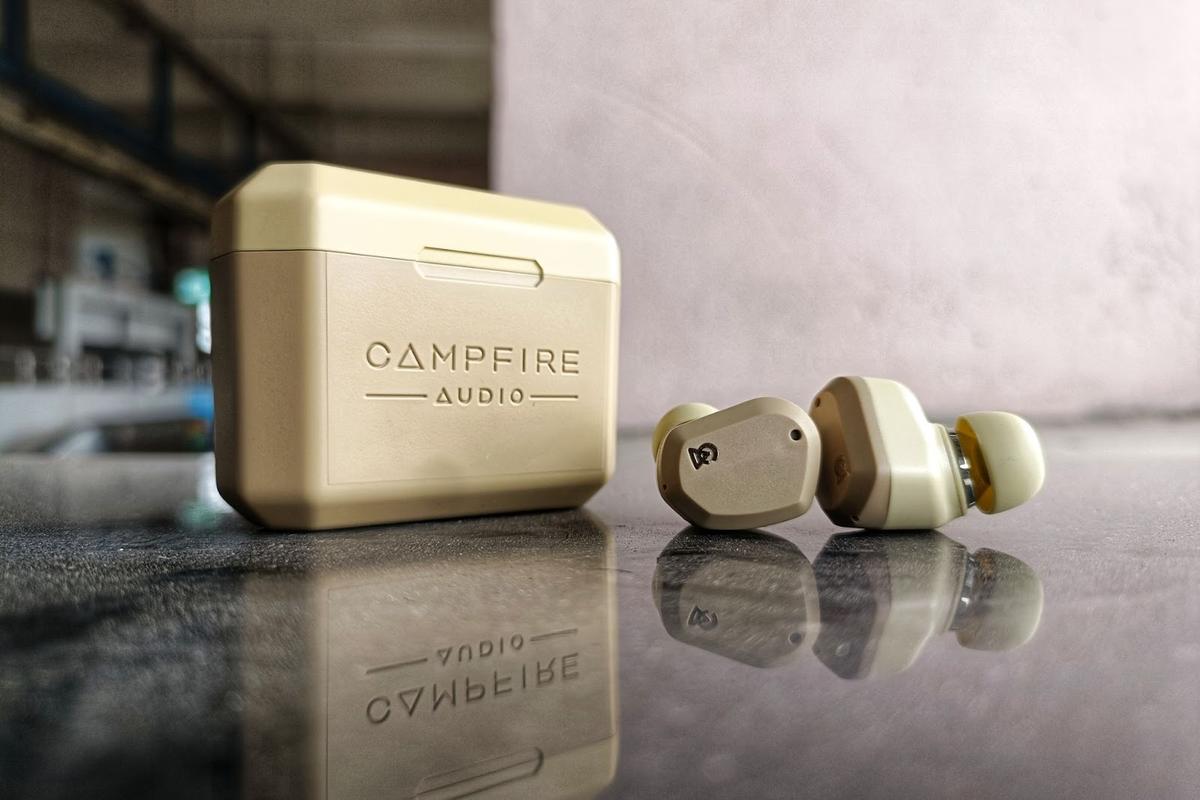While the Orbit are sonically above average, the mic fails to impress.
- Smooth midrange and treble
- Fast pairing and intuitive controls
- Sufficient battery life
- Good app support and EQ options
- Decent voice pick-up in a quiet environment
- Generic thick bass
- No background noise suppression
- No wear detection
- Stock tips do not seal well
Campfire Audio is a very reputed brand in the audiophilia world. They have consistently created impressive products in various price ranges. The Orbit is their first pair of true wireless (TWS) earphones.
The Orbit have a fun and relaxing sound profile featuring a single dynamic driver, an ergonomic fit, and customizable touch controls perfect for unintrusive daily on-the-go usage. I particularly like their elegant and minimal looks.
Unboxing and First Impression
Case ⓘ
Battery ⓘ
- Battery Life: 30 hours
- Connector: USB Type-C
- Wireless Charging: Yes
- Battery Capacity: 270mAh
Despite the form factor, the case’s battery life is reasonably long.

UX ⓘ
- Can be opened easily with one hand: Yes
- Pass the shake test: Yes
- Light Indicators: Displays battery level and charging status
- Reset Button: Used to turn on Bluetooth pairing and factory reset
I can easily open the case with one hand. The LED indicators inside the charging case between the earbuds denote the battery level and indicate charging.
The reset button can be pressed for 3 seconds to enter into the Bluetooth pairing mode. Hold for 10 seconds to trigger a factory reset. Once in Bluetooth pairing mode, the indicator lights will flash in a marquee pattern.
Design ⓘ
- Shape of the case: Rectangular
- Material: Plastic
- Build Quality: Premium

The case’s plastic build has a matte finish similar to the earbuds that feels premium to the touch. The joint of the lid is firm but operates smoothly.
Portability ⓘ
- Weight: 45g (With earbuds inside, 5.9g on each side)
- Volume: 5.9 x 4.5 x 2.3 = 61.07 cm (~3.73 cu)
- Portability: Outstanding
The ergonomic shape of the case has an optimal ratio such that it is quite easy to carry in a pocket.
Earbuds ⓘ
Battery ⓘ
- Battery Life: 8.5 hours
- Battery Capacity: 50mAh
- Charge Time (15 mins): Around 2 hours playback time – calculated based on 1 hour needed for a full charge
The 8.5 hours of battery life really works for uninterrupted daily usage. I can wear them all day without charging.

UX ⓘ
- Control Mechanism: Touch
- Touch Accuracy: Good
- Control Symmetry on both earbuds: No
- Mono Use: Yes, both sides
The faceplates of the earbuds serve for touch control. One tap on either side will play/pause music. A double tap on the left side will go to the previous track, and a double tap on the right will play the next track. A triple tap on either side will trigger the voice assistant.
A long press on the right side will increase the volume, and a long press on the left will decrease the volume.
When a call is incoming, on either side, a single tap will answer the call, a double tap will reject the call, and during a call, a single tap on either side will hang up the call.
Design ⓘ
- Profile: Medium
- Material: Plastic
- Comfort: Outstanding
- Fit: Outstanding
The Orbit have a very low-key design with excellent build quality. The beige color feels quite classy. The profile is not very big, but they still slightly stick out from my ears. They fit very comfortably with no irritation and no undue pressure.

Mic ⓘ
- Noise Cancellation: Substandard
- Voice Pick-up: Good
I find the mic performance of the Orbit merely average. While clear in quiet environments, as soon as the environmental noise approaches 80 dB, my voice becomes suppressed and muffled.
There is zero background noise suppression – they are not usable in noisy environments like trains or airports.
Mic demo
Sound ⓘ
- Driver: Custom full-range 10mm liquid crystal polymer dynamic driver
- Sound Signature: V-shaped
- Bass: Average
- Midrange: Good
- Treble: Good
- Sound Detail: Average
The Campfire Audio Orion have a distinctly warm and relaxed sound signature. This profile suits casual listening but not if you are looking for sheer resolution. The overall sound is very cohesive, fun and laid-back, providing a non-fatiguing listening experience.
The Orion focus more on the musicality of the track rather than the finer details.
There are quite few EQ modes to choose from: Clarity, Folk, Hip Hop, Loudness, Moonstar, Podcast, Quiet, and Rock. The modes with the most distinct characteristics are Clarity, Loudness, Quiet, and Rock. The rest are just minor variants of these.
Rock makes the signature a more prominent V, Loudness increases the amplitude of all three frequencies, Quiet reduces them, and Clarity reduces the bass frequencies, making the mid and treble more forward.
I prefer the Clarity equalizer mode as it provides the best balance.
Bass
The bass feels thick and strong. It is more on the fun side. Subbass generates considerable rumble and midbass slam is powerful, but the textures are a little blurred due to the thick notes. The decay is slow, which adds to the voluminous presence.
This region is generic sounding without unique tuning.

Midrange
The midrange is smooth, and the emphasis is more on the lower mids than the upper mids. Vocals and instruments have full-bodied notes with slightly rounded edges. Compared to the bass, the midrange is somewhat pushed back but does not sound muted.
The midrange can lack bite, though.
The upper midrange has decent clarity and sufficiently crisp notes. Female vocals do not sound off, and instruments are clearly distinguishable.

Treble
The treble section is smooth but has a pleasant amount of energy. This section is tuned for extended, relaxed listening while maintaining above-average clarity. It primarily focuses on the lower treble, as the upper treble rolls off relatively early.
The lower treble sounds quite nice, with enough sparkle.
I would prefer more emphasis on the upper treble. As such, the air is rather compromised here. But the brilliance in the lower treble retains the required engaging touch without sounding sibilant.
Soundstage, imaging, and details
The Orbit have an intimate and cohesive presentation over a well-separated and spacious one. The soundstage is intimate and two-dimensional, with relatively less depth. The imaging is also merely average. Notes have above-average definition but are definitely not high resolution.

Connectivity ⓘ
- Audio Codec: AAC, SBC, AptX, AptX HD
- Bluetooth Version: 5.2
- Auto-connect when: Case cover is opened
- Average drop-outs in an hour: 0 – 1
- Multi-point connection: No
The connectivity of the Orbit is reasonably good. The pairing is a smooth process, and once paired, they connect within a second of opening the lid. I only encountered two drop-outs during testing, so that is not an issue.
The absence of a multi-point connection is a bummer, especially given the price point.
Waterproof ⓘ
- IP Rating: IPX5
The Orbit have an IPX5 water resistance rating, meaning they can handle a sustained low-pressure (up to 30 kPa) water spray from around 3 m distance from any angle for up to 15 min. Suffice it to say they are safe from regular light rain, sweat, etc., making them perfect for outdoor activities.
Software ⓘ
- Available on: iOS, Android
- Touch controls
- Firmware upgrades
- Equalizer – Preset and customizable modes
- Earbuds battery status
- Active codec

I find the android application comprehensive and easy to browse. All the possible and necessary actions are at the forefront. The first tab shows the current battery status, touch controls, and the active codec.
In the equalizer section, you can choose EQ settings based on your preference or add a customized 7-band equalizer to make your own preferred setting.
I wish that the touch controls could be modified. Currently, the touch controls are set, and you can only turn them on or off from the app.
Comparisons
Vs. Edifier Neobuds Pro 2
The Neobuds Pro 2 are distinctly different from the Orbit in both build and driver setup. They have a stemmed design, with a hybrid driver setup containing 1 DD and 1 BA driver.
Feature-wise, on paper, the Neobuds Pro 2 are considerably ahead of the Orbit with multi-channel ANC with several levels of noise cancellation, spatial audio with visualized head-tracking, and AI voice pick-up algorithm with 4+4 built-in microphones.
The Neobuds’ ANC is surprisingly effective and reduces ambient noise very effectively even in it’s lowest setting. This is a huge step up over the passive noise cancellation of the Orbit. The IP54 dust and water resistance also purportedly better than the Orbit’s IPX5.
The mic performance of the Neobuds Pro 2 is slightly better than the Orbit. My voice sounds slightly more clear. However, there is barely noticeable improvement in the voice pick-up in a noisy environment, if any at all.
The Neobuds Pro 2 have a very sharp V-shaped signature. The bass is tighter on the Neobuds Pro 2 and has more texture. The midrange sounds thinner, with significantly more transparency. The Neobuds’ treble is more forward and brighter but sometimes piercing and uncomfortable on sibilant tracks.
On the other hand, the Orbit provide a more laid-back and balanced sound. The midrange sounds rich and organic, and the treble sounds refined despite being pushed back a little. Sure, they do not sound very transparent, but the coherency in the overall sound profile is definitely pleasant.
Who Should Buy This?
The Campfire Orbit are perfect for indoor use. They are comfortable, the sound is pleasant, and the mic works well in low-noise environments. One can easily wear them and be engaged in active indoor workouts due to the IPX5 protection and great fit.
However, once you take them outdoors, the scenario changes. Yes, you can still enjoy the music, but when it comes to calls, you will definitely be inconvenienced due to the sub-par voice pick-up in noisy environments.
Final Thoughts
The Campfire Orbit are a well-tuned set of TWS earbuds. They have a distinct sound signature that is well-crafted, regardless of whether it suits everybody’s preference.
The smooth midrange and treble are easy on the ear. The intimate presentation is cozy but not super congested. The bass is rather supplementary but not boomy or mushy.
I appreciate the excellent build and competent app. The microphone performance is also okay if you go into a noisy environment where it struggles.
The Orbit do many things right – like the intuitive controls, well-tuned midrange and treble regions, comfortable fit, and IPX5-resistant premium build. However, for their asking price of around USD$250, I can not excuse the absence of ANC and merely average microphone performance.
These shortcomings make them somewhat difficult to recommend, considering the price.
Where to Buy
Company Overview
Campfire Audio is a small team of audio engineers, designers, and craftspeople dedicated to taking the listening experience to another level. Located in Portland, Oregon, USA, they started in 2015 and quickly gained popularity with their quality products across multiple price brackets.
What’s in the Box?
- Orbit TWS earphones
- Charging case
- USB-c cable
- Silicone and foam ear tips
- Campfire Audio pin
- User manual

Technical Specifications
- Form: TWS
- Driver: Custom full-range 10mm dynamic driver with LCP diaphragm
- Waterproof IP Rating: IPX5
- Weight (g): 5.9g each side
- Frequency Response (Hz): 5Hz – 20KHz
- Bluetooth Version: 5.2
- Bluetooth Audio Codec: AAC, SBC, AptX, AptX HD
- Battery Life (hrs): 8.5 hours IEMs + 30 hours case
- Mic: Y
